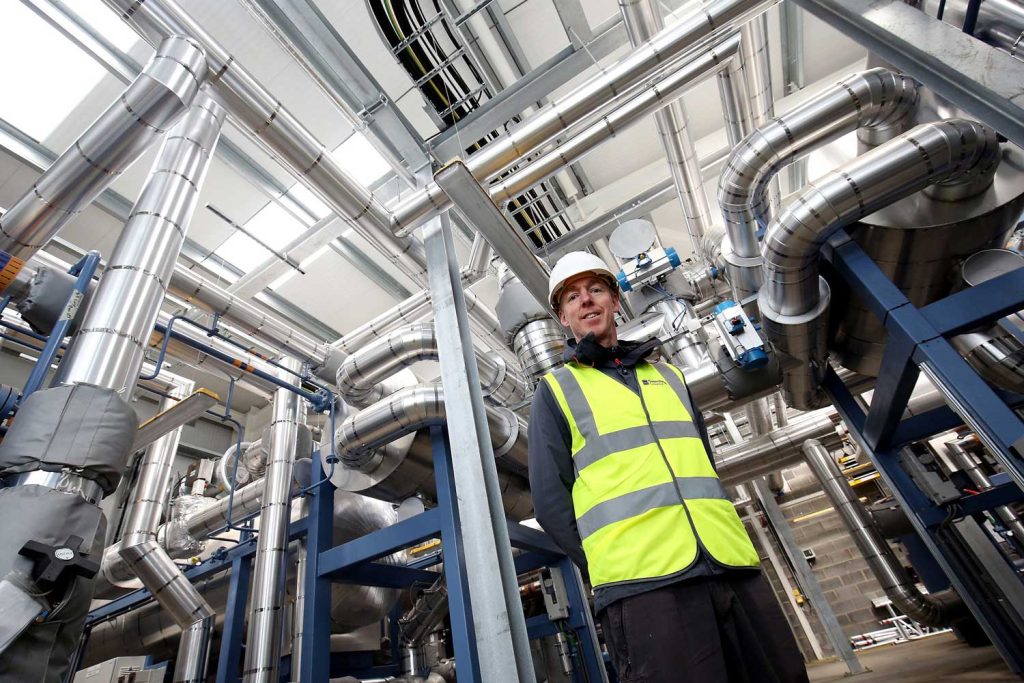Power utilities in Europe are floating plans for innovative applications with large-scale heat pumps, in a bid to decarbonize their district heating systems.
German utility RheinEnergie has unveiled plans for a large-scale heat pump that will use the energy of the Rhine River to deliver 150 MW of heat output. The heat will be available to the district heating network in central Cologne as “green heat.”
The system will be able to heat around 30,000 residential units and is poised to increase RheinEnergie’s existing district heating network capacity by 15%. Construction is scheduled to start early next year and commissioning is planned for early 2027. Another 50 MW heat pump will be installed in the Merkenich district in northern Cologne.
Meanwhile, in the United Kingdom, Gateshead Energy Company has delivered what is described as “the largest mine water heat network in Great Britain and one of the largest in Europe.” The system will use warm water from the extensive network of old coal mining infrastructure 150 meters below the town of Gateshead, in order to supply heat and hot water to different building types, including homes, businesses, and community buildings.
A 6 MW water source heat pump recovers heat and distributes it via the existing district heating network over five kilometers long. The mine water at 15 C is taken from drilled boreholes and passed through a heat exchanger which transfers heat, via a heat pump, into a network of underground pipes that supply hot water at 80 C to homes and buildings.
Mine water does not flow through the network, which heats the buildings, but is instead returned to the ground once the natural heat is extracted. The scheme took about three years to deliver and went live in late March.
Separately, Danish utility DIN Forsyning says it is poised to supply the seaport town of Esbjerg, Denmark, with zero-emissions district heating by using two large-sized heat pumps. MAN Energy Solutions supplied two 50 MW pumps. They will be powered by nearby wind farms and will use the Wadden Sea as a heat source.
The heat pumps, which will replace coal-fired heat, will provide 25,000 households with heat and produce 350,000 MWh of heat per year. The heat pump can reach a maximum temperature of 150 C and will deliver water to the city’s district heating network at 90 C. The systems are expected to be commissioned in the fall.
Implementing heat pumps in district heating systems is a relatively unexplored application. However, it offers enormous potential for large-scale heat decarbonization.
In Germany, specifically, large-scale heat pumps could provide about 70% of district heating by 2045, according to a recent study commissioned by think tank Agora Energiewende and conducted by Fraunhofer IEG. This would mean that the country would need to add as much as 4 GW of large-scale heat pumps per year. Currently, Germany has just 60 MW of installed capacity, with another 600 MW under development, according to Fraunhofer IEG.
This content is protected by copyright and may not be reused. If you want to cooperate with us and would like to reuse some of our content, please contact: editors@pv-magazine.com.




By submitting this form you agree to pv magazine using your data for the purposes of publishing your comment.
Your personal data will only be disclosed or otherwise transmitted to third parties for the purposes of spam filtering or if this is necessary for technical maintenance of the website. Any other transfer to third parties will not take place unless this is justified on the basis of applicable data protection regulations or if pv magazine is legally obliged to do so.
You may revoke this consent at any time with effect for the future, in which case your personal data will be deleted immediately. Otherwise, your data will be deleted if pv magazine has processed your request or the purpose of data storage is fulfilled.
Further information on data privacy can be found in our Data Protection Policy.